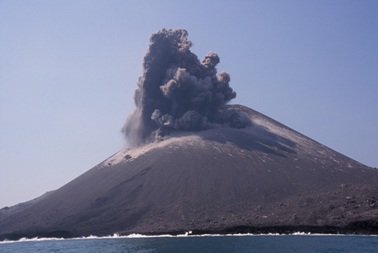 Mount Anak Krakatau continues its frenzied expulsion of volcanic material, including hot rocks, sand and dust shrouded in toxic fumes — seven times more frequently than just a week earlier.
Mount Anak Krakatau continues its frenzied expulsion of volcanic material, including hot rocks, sand and dust shrouded in toxic fumes — seven times more frequently than just a week earlier.
“Usually Mt. Anak Krakatau experiences an average of 90 to 100 small scale eruptions a day. Now, the number of eruptions can reach 700 a day,” Andi Suhardi, head of the Mt. Anak Krakatau observation post in Hargo Pancuran village, said on Monday.
Mt. Anak Krakatau is a volcano located near Krakatau Island between Sumatra and Java.
“Solid material falls on the mountain slopes. However, the sand and volcanic dust can cover greater distances depending on how strong the wind blows,” Andi said.
He added that Krakatau’s volcanic activity has been increasing slowly since last Monday, reaching almost 90 eruptions per day. Activity further escalated after Mt. Merapi in Central Java erupted, he said.
A day before the latest eruption, authorities raised the alert status for Mt. Anak Krakatau and advised people to stay at least several kilometers away. “We advise fishermen and tourists not to come within a radius of 3 kilometers of Krakatau. The thick plumes of smoke sent off by Krakatau contain toxic material that is hazardous for your health,” Andi said.
Although Mt. Krakatau’s rumblings increased after Mt. Merapi’s eruption, volcanologists claimed that no link existed between the active volcanoes. “No connections exist between the two because they both have their own magma pockets,” Agus Budiyanto, head of the volcano observation team at the Center of Volcanology and Geological Mitigation Agency (BPVMG) in Bandung, West Java, said.
Lucas Donny Setijadji, a volcanologist from Gadjah Mada University in Yogyakarta, said that the weak, local seismic tremors produced by Mt. Merapi’s eruptions lacked sufficient energy to trigger volcanic eruptions elsewhere, including at Mt. Krakatau.
However, there was a possibility that the eruptions of Mt. Merapi, and Mt. Krakatau were triggered by tectonic movements caused by the Mentawai earthquake, he said.
A 7.2-magnitude earthquake epicentered near South Pagai in the Mentawai Islands regency, rattled the region last Monday and generated a 2-meter tsunami that killed 449 people. “Based on observation alone, Mt. Merapi erupted not long after the earthquake occurred,” Lucas said.
He added that sliding tectonic plates during the earthquake could have created new fissures that acted as conduits for magma. The plates could have shifted and pushed against the “magma kitchen” below Mt. Merapi, thus creating pressure that pushed the magma upwards, he added.
“The stability of the magma below became disturbed,” he told The Jakarta Post.
Sumatra and Java Islands are on the fringes of the Indo-Australian and Eurasian continental plates and are part of the so-called Ring of Fire, home to a large number of volcanoes.


